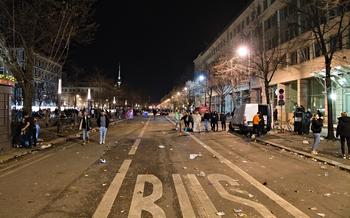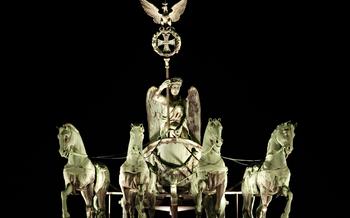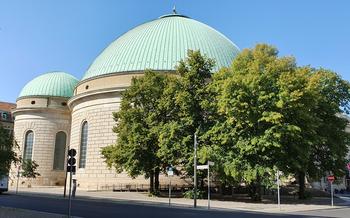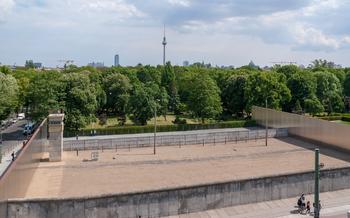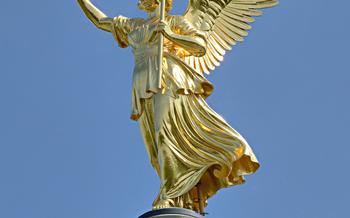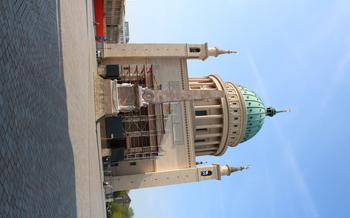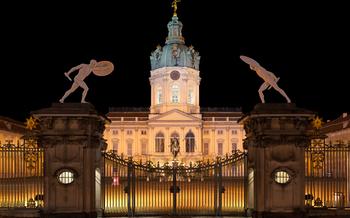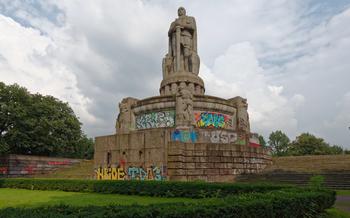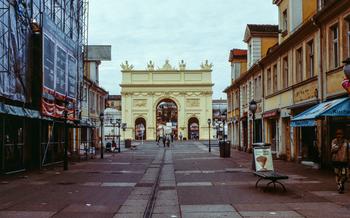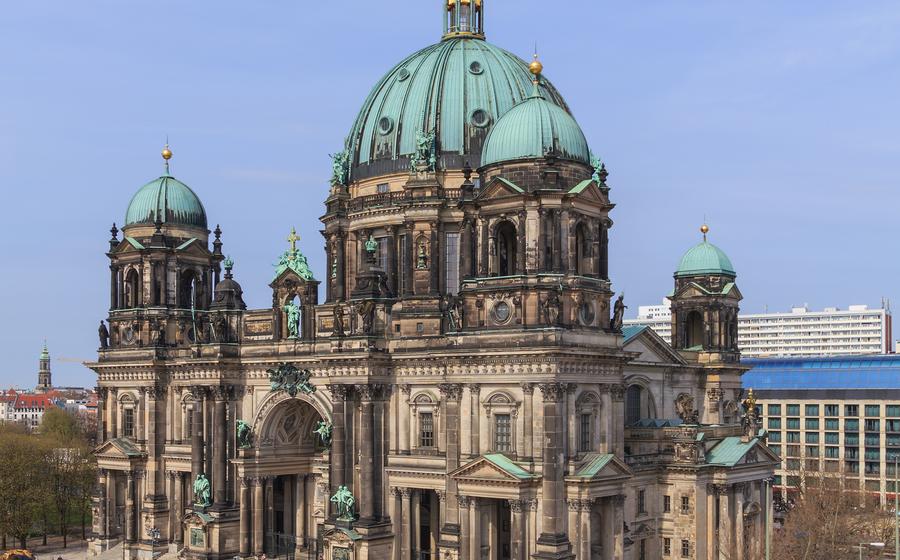
Berlin Cathedral
- Berlin Cathedral: A Majestic Landmark
- History of the Berlin Cathedral
- Architectural Highlights
- Interior Grandeur
- Religious Significance
- Dome Climb: A Unique Perspective
- Crypts and Tombs: A Glimpse into German History
- Guided Tours
- Events and Concerts
- Accessibility and Facilities
- Location and Transportation
- Opening Hours and Admission
- Insider Tip: Hidden Gem
Berlin Cathedral: A Majestic Landmark
In the heart of Berlin, on the picturesque Museum Island, stands the Berlin Cathedral, an iconic symbol of German history and culture. This majestic edifice, with its grand Neo-Renaissance architecture and imposing dome, has witnessed centuries of religious, political, and social transformations.
The Berlin Cathedral holds immense historical significance as a symbol of German unity. It was built in the late 19th century under the reign of Kaiser Wilhelm II to represent the power and prestige of the newly unified German Empire. The cathedral's architectural style reflects the prevailing zeitgeist, combining elements of Renaissance, Baroque, and Gothic influences.
Beyond its historical significance, the Berlin Cathedral is renowned for its architectural grandeur. The impressive dome, towering over the city skyline, is a testament to the architectural prowess of the era. Intricate sculptures and carvings adorn the facade, while stunning stained glass windows illuminate the interior with vibrant hues.
The Berlin Cathedral is not merely a historical monument but also an active place of worship. It serves as the seat of the Evangelical Church in Berlin-Brandenburg-Silesian Upper Lusatia, hosting regular church services, concerts, and events. The cathedral stands as a symbol of religious tolerance and understanding, welcoming visitors of all faiths and backgrounds.
History of the Berlin Cathedral
The Berlin Cathedral, a majestic landmark in the heart of Germany's capital, boasts a rich and storied history that mirrors the tumultuous events of German society. Its origins can be traced back to the 14th century, with the construction of a modest church dedicated to St. Nicholas. Over time, the church underwent several expansions and renovations, reflecting the growing prominence of Berlin as a political and cultural center.
In the 19th century, the decision was made to construct a grander cathedral that would befit the status of Berlin as the capital of the newly unified German Empire. The foundation stone for the new cathedral was laid in 1894, and the construction was completed in 190The cathedral was designed by Julius Raschdorff in a Neo-Renaissance style, incorporating elements of Italian Renaissance architecture.
During World War II, the Berlin Cathedral suffered significant damage from Allied bombings. The dome was destroyed, and the interior was gutted by fire. After the war, the cathedral underwent an extensive reconstruction process that lasted for several decades. The restoration work was guided by the principles of historical preservation, ensuring that the cathedral's original grandeur was meticulously restored.
Throughout its history, the Berlin Cathedral has played a significant role in German history. It served as the royal chapel for the Hohenzollern dynasty, and many members of the royal family are buried in the cathedral's crypts. The cathedral has also been a witness to major historical events, including the proclamation of the German Empire in 1871 and the reunification of Germany in 1990.
Today, the Berlin Cathedral stands as a cultural landmark and a symbol of German history. It is a testament to the resilience of the German people and their ability to rebuild after times of adversity. The cathedral continues to serve as a place of worship, a venue for cultural events, and a popular tourist destination.
Architectural Highlights
The Berlin Cathedral stands as a testament to the grandeur of Neo-Renaissance architecture, boasting an array of captivating features. Its imposing dome, a symbol of power and resilience, dominates the skyline, inviting visitors to marvel at its intricate details and sheer scale. As they approach the cathedral, their eyes are drawn to the intricate sculptures and carvings that adorn the facade, each one a masterpiece of artistry that narrates a tale from the Bible or German history.
The interior of the cathedral is no less awe-inspiring, with its spacious nave creating a sense of vastness and tranquility. The ornate altar, a testament to the skill of master craftsmen, commands attention with its intricate carvings and shimmering gold leaf. The impressive organ, with its multitude of pipes and towering presence, adds to the cathedral's grandeur and is a testament to the importance of music in its religious ceremonies.
The Berlin Cathedral is also home to a collection of stunning stained glass windows, each one a work of art that depicts scenes from the life of Christ and the history of the church. The vibrant colors and intricate details of these windows create a mesmerizing effect, casting a warm and ethereal glow throughout the cathedral's interior.
Interior Grandeur
Step inside the Berlin Cathedral, and you will be greeted by a breathtaking display of architectural mastery. The spacious nave, adorned with intricate carvings and soaring arches, creates a sense of awe and grandeur. The focal point of the interior is the ornate altar, a masterpiece of craftsmanship featuring intricate carvings, gold leaf embellishments, and a magnificent altarpiece.
As you explore further, you will encounter the impressive organ, one of the largest and most renowned in Germany. With its 7,000 pipes and intricate facade, it is a true work of art that has filled the cathedral with its majestic sounds for over a century.
The cathedral also houses several royal tombs and memorials, paying homage to the Hohenzollern dynasty, who played a significant role in German history. These elaborate tombs, adorned with sculptures and inscriptions, offer a glimpse into the lives and legacies of the former Prussian rulers.
Religious Significance
The Berlin Cathedral holds immense religious significance as a prominent Protestant cathedral, serving as the seat of the Evangelical Church in Berlin-Brandenburg-Silesian Upper Lusatia. It is a symbol of religious tolerance and unity, welcoming people from all faiths and backgrounds. Regular church services, prayer meetings, and special events are held within the cathedral, fostering a sense of community and spirituality. Notable figures from the church's history, such as Martin Luther and Dietrich Bonhoeffer, have left their mark on the cathedral, contributing to its rich religious heritage. Visitors can witness the grandeur of Protestant ceremonies, admire the intricate religious iconography, and experience the profound spirituality that permeates the cathedral's atmosphere.
Dome Climb: A Unique Perspective
For a breathtaking panorama of Berlin, ascend the 270 steps to the cathedral's dome. This exhilarating climb rewards you with unparalleled city views, stretching from the iconic Brandenburg Gate to the lush Tiergarten park. Along the way, marvel at the intricately carved inscriptions that adorn the dome's interior, providing a glimpse into the cathedral's rich history. From the viewing platform, immerse yourself in the grandeur of Berlin's cityscape, with its blend of historic landmarks and modern skyscrapers. Remember to bring your camera to capture this unforgettable moment.
Tips for a Memorable Climb:
- For the best views, plan your ascent on a clear day.
- Wear comfortable shoes for the climb.
- Take your time to enjoy the historical inscriptions along the way.
- If possible, time your visit to coincide with sunset for a magical view of the city bathed in golden light.
Crypts and Tombs: A Glimpse into German History
Beneath the grandeur of the Berlin Cathedral lies a hidden world of history and remembrance—the crypts and tombs. Here, in the depths of the cathedral, rest the mortal remains of Hohenzollern royalty, their stories entwined with the rich tapestry of German history.
Elaborate sarcophagi and sculptures adorn the crypts, each a testament to the artistry and craftsmanship of a bygone era. These resting places offer a glimpse into the lives and legacies of the Hohenzollern dynasty, who ruled over Prussia and Germany for centuries.
Visitors can wander through the crypts, paying their respects to the departed monarchs and learning about their contributions to German history. The crypts provide a unique perspective on the lives of these powerful figures, shedding light on their triumphs and tribulations, their ambitions and their failures.
When visiting the crypts, it is important to remember that these are sacred spaces where the departed are laid to rest. Visitors are expected to be respectful and maintain a quiet demeanor. Photography is generally not permitted in the crypts, as a sign of respect for the deceased.
By exploring the crypts and tombs of the Berlin Cathedral, visitors can gain a deeper understanding of German history and culture. These hidden chambers offer a glimpse into the lives of the powerful Hohenzollern dynasty and provide a tangible connection to the past.
Guided Tours
To delve deeper into the cathedral's rich history and architectural nuances, guided tours are a must. Knowledgeable and passionate guides lead visitors through the grand edifice, sharing captivating stories and insights that bring the cathedral's past to life. Thematic tours are also available, catering to specific interests such as art, history, or religion. These tours provide an immersive experience, allowing visitors to explore the cathedral's hidden corners and learn about its significance from experts.
Booking a guided tour is highly recommended, especially during peak tourist season. Reservations can be made online or through the cathedral's information desk. Tours are available in multiple languages, ensuring that international visitors can also fully appreciate the cathedral's grandeur. Whether you're a history buff, an architecture enthusiast, or simply curious about this iconic landmark, a guided tour will elevate your visit to the Berlin Cathedral.
Events and Concerts
The Berlin Cathedral is not just a place of worship, but also a vibrant cultural hub that hosts a wide range of events and concerts throughout the year. From classical music performances to special events during holidays and festivals, there's something for everyone at this awe-inspiring venue.
Classical Music Performances
The Berlin Cathedral has a long tradition of hosting classical music concerts, featuring renowned musicians and ensembles from around the world. The cathedral's exceptional acoustics and intimate atmosphere make it a perfect setting for enjoying the beauty of classical music. From Bach to Beethoven, Mozart to Mendelssohn, the cathedral's concert calendar is filled with a diverse range of musical experiences.
Special Events
During the holiday season, the Berlin Cathedral transforms into a magical setting, hosting special events and concerts that celebrate the spirit of Christmas and the New Year. From festive choral performances to traditional German Christmas markets, there's no better place to experience the magic of the holidays than at this iconic landmark.
Booking Tickets and Event Information
To ensure your visit to the Berlin Cathedral for an event or concert is seamless, it's advisable to book your tickets in advance. You can purchase tickets online or at the cathedral's box office. For more information on upcoming events and concerts, visit the Berlin Cathedral website or contact the cathedral office directly.
Accessibility and Facilities
The Berlin Cathedral is committed to providing an inclusive and accessible experience for all visitors. Wheelchair users can easily navigate the cathedral's interior through designated ramps and elevators. Audio guides are available in multiple languages to enhance the visit for international guests. A cloakroom and restrooms are conveniently located within the cathedral for visitor convenience. Visitors with disabilities can find detailed accessibility information on the cathedral's website or by contacting the visitor center. The cathedral staff is always ready to assist and ensure a seamless and enjoyable experience for everyone.
Location and Transportation
The Berlin Cathedral is strategically located on Museum Island, which is a UNESCO World Heritage Site. This central location makes it easily accessible by various means of public transportation. Visitors can take the U-Bahn (metro) lines U5 or U6 and get off at the "Museumsinsel" station. Alternatively, they can take a bus such as the M1 or M48 and stop at the "Am Kupfergraben" or "Lustgarten" bus stops. For those who prefer a leisurely stroll, the cathedral is within walking distance from other popular attractions, such as the Brandenburg Gate, the Reichstag, and the Holocaust Memorial.
Opening Hours and Admission
The Berlin Cathedral is open to visitors daily, except on certain holidays. Opening hours are generally from 9 am to 6 pm, but it's always advisable to check the official website or consult a reliable travel guide for the most up-to-date information.
Admission to the cathedral is charged, with different rates for adults, students, and children. There are also concessionary rates for families and groups. Admission fees contribute to the upkeep and preservation of this magnificent landmark.
On certain days and times, usually during religious services, admission to the cathedral may be free of charge. It's worth checking with the cathedral office or the website to find out about these special free entry periods.
To avoid crowds and long lines, it's recommended to visit the cathedral during less popular hours, such as early in the morning or late in the afternoon. This way, you can fully appreciate the cathedral's grandeur and tranquility without feeling rushed.
Insider Tip: Hidden Gem
Amidst the grandeur of the Berlin Cathedral, there lies a secret corner that offers a moment of tranquility and invites the curious to discover a hidden treasure. Tucked away in a secluded alcove, behind intricate carvings and towering pillars, lies a small, unassuming chapel. Its muted colors and gentle lighting create a serene atmosphere, a stark contrast to the opulent splendor of the main cathedral.
Step inside this hidden sanctuary, and you'll be greeted by a breathtaking stained-glass window depicting a serene biblical scene. The soft, dappled light filtering through the colorful glass casts a warm glow upon the humble wooden benches and worn stone floor. It's a place where time seems to stand still, inviting you to pause, reflect, and connect with the spiritual essence of this sacred space.
As you sit in silence, take a moment to admire the intricate details of the chapel's architecture. Notice the delicate tracery of the vaulted ceiling, the graceful arches that frame the stained-glass masterpiece, and the subtle carvings that adorn the walls. It's a testament to the craftsmanship and devotion of the artisans who created this hidden gem.
Whether you're seeking a moment of solace amidst the bustling crowds of tourists or simply want to experience the cathedral from a unique perspective, this secret chapel is worth seeking out. It's a place where the true spirit of the Berlin Cathedral can be felt, away from the throngs of visitors and the grandeur of the main sanctuary.
